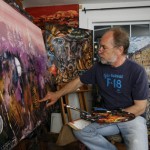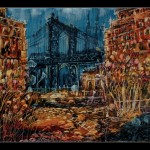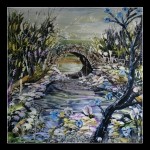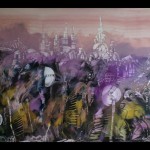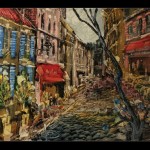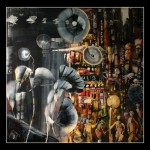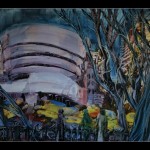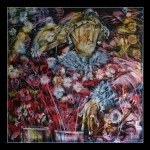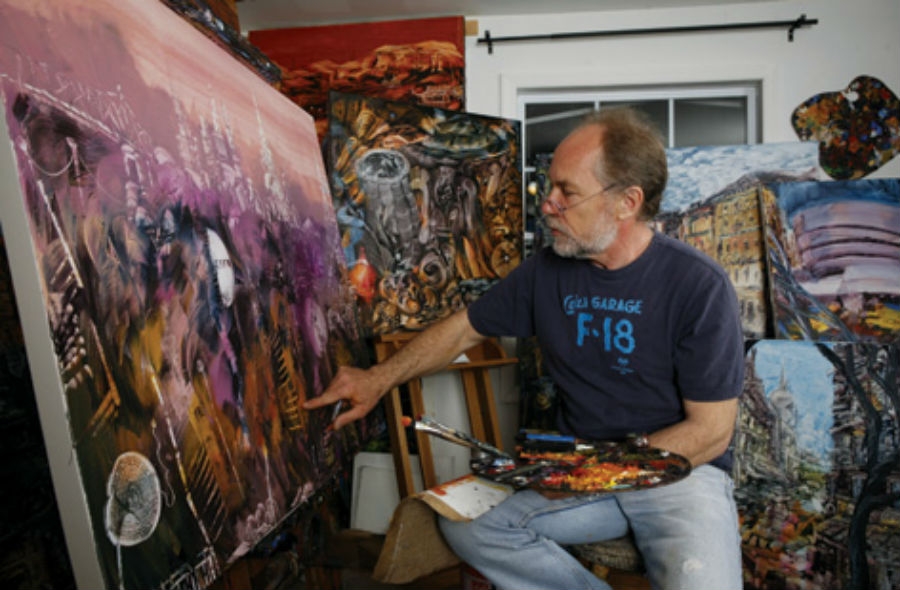
Concepts are transformed into color and landscape in the worlds cast across Oleg Falkov’s canvases.
His paintings take viewers to wild places laden in dark outline and rough abstraction, a window on a familiar road or bridge that’s been lit on fire with color. He paints in a dark metaphorical way – the empty parts of each scene are filled in with black and dark blue, making each picture whole as the dark sky stretches down to meet the buildings and trees.
Falkov says he works to connect an impressive phantasmagoric image with symbolism to create a complete artistic concept. “But I have to pay a high price for this kind of synthesis and it is very easy to cross the border and make it look ‘bizarre,'” he says. “Sometimes I do, and thus have to ruthlessly destroy a finished painting.”
The works that survive impeccably demonstrate that synthesis of style and ideas, turning a typical landscape into an untamed scene that only hints at man’s existence by revealing some of his greatest creations. His most recent project is called “Hidden New York,” a series of paintings that examine the landscapes of New York City through Falkov’s dramatic, experience-inducing style.
This experience comes from entering a place with abstracted connections, where things are recognizable but not logically composed. “The overlapping volumes, strange shapes and unusual items are there for the viewer to be more alarmed and awake,” he says, “When I finish a painting, I also become a spectator… I can’t judge whether I am succeeding in it, but I feel the indescribable bliss from the tunes I invent on my canvases.”
In his work “Manhattan Bridge,” warm yellows mix with hot oranges to meet a pale blue sky. The bridge rises up in dark black against the blue, a triumphant declaration of architectural power that’s supported by the spikes of the Chrysler Building and the Empire State Building that pierce the sky in the background. Buildings in Brooklyn frame the view on either side, creating three dynamic angles within the canvas’s three dimensions.
After more than fifteen years of painting, his abstract art work can be found all around the world, including Kazakhstan’s State Art Museum and the Consulate General of the Republic of Poland. His work has been exhibited in New York and Los Angeles and there is an exhibition scheduled in Hong Kong in 2014.
Oleg Falkov still works constantly, always searching for ways to reflect the world in a truer sense than how reality presents it. “As an artist, I am always contemplating eternity of the universe.” he says. “I’m trying to do my best and catch a grain of that eternity on my canvas.”
One of the most important themes in his work comes in the absence of a human presence, something Oleg Falkov says indicates his own absence from the paintings – they become uninhabited worlds where access is exclusive and only those Falkov calls “defiant loners” can enter. But even so, he acknowledges that the intention of each work is for the most open interpretation possible, he only wishes to leave each viewer with the ability to find beauty in everyday things. “My brush balances uneven and if the heart of my audience is beating in resonance with my heart, it is easy for them to sink into my paintings and understand it better,” he says. “The dialogue of life should not be confined within the image frame.”


